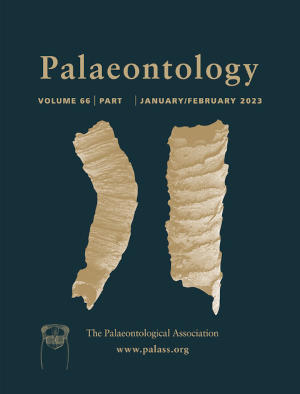Article: Did the Late Ordovician mass extinction event trigger the earliest evolution of ‘strophodontoid’ brachiopods?
Publication: Palaeontology
Volume:
66
Part:
2
Publication Date:
2023
Article number:
e12642
Author(s):
Bing Huang, Di Chen, David A.T. Harper, and Jiayu Rong
Abstract
Abstract ‘Strophodontoid’ brachiopods represented the majority of strophomenide brachiopods in the Silurian and Devonian periods. They are characterized by denticles developed along the hinge line. The evolution of denticles correlated with the disappearance of dental plates and teeth and were already present when the clade originated in the Late Ordovician. Specimens of Eostropheodonta parvicostellata from the Kuanyinchiao Bed (early–middle Hirnantian, uppermost Ordovician) in the Hetaoba Section, Meitan, Guizhou Province, South China, display clear fossil population variation, during a process of loss of dental plates and the development of denticles. Three phenotypes of E. parvicostellata are recognized in a single fossil bed, likely heralding a speciation process. Non-metric multidimensional scaling (NMDS) based on five key characters of genera of the Family Leptostrophiidae shows a much wider morphospace for Silurian genera than for those in the Devonian. Phylogenetic analysis of the Family Leptostrophiidae supports the NMDS analysis and mostly tracks their geological history. The fossil population differentiation in E. parvicostellata discovered between the two phases of the Late Ordovician mass extinction event (LOME) linked to a major glaciation, suggests a Hirnantian origination of the ‘strophodontoid’ morphology, and links microevolutionary change to a macroevolutionary event.
